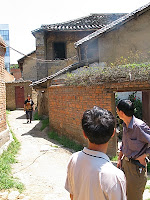Bamboo and Rattan @ the Clark
Sunday, May 31, 2009
My interest in Japan goes back to high school. I finished a year of Japanese language at Pasadena City College and a year of its history at UCLA. So I’ve been vaguely aware of the Clark Center for Japanese Art & Culture for several years. I’d just never gotten there..jpg) The Clark sits only 28 miles from my doorstep, but it’s not in a direction I’m accustomed to travel.
The Clark sits only 28 miles from my doorstep, but it’s not in a direction I’m accustomed to travel.
Yamaguchi Ryuun, White Wave, 2006
Kings County is largely dairy country, the milking sheds and herd corrals interrupted only by the alfalfa fields that support them. Most of the dairy families trace their roots to recent immigrants from Holland or the Azores. It’s not the kind of landscape where one would expect to find one of only two museums in America dedicated entirely to Japanese art.
The land has a poor record for supporting high culture. In the late 1970s, a Canadian hoping to found a Shakespearian theater studied a map, saw a ‘Stratford’ (another 14 miles of dairy land beyond the Clark) roughly midway between the Los Angeles and San Francisco markets, and came for a look. At Stratford, he found a fork in the road, a hay barn, and some farm-worker housing. Not ready to give up, he backtracked through Hanford and all the way to Visalia before he could find a host community for his company. For several seasons, they produced some fine theater, but the L.A. and S.F. crowds never materialized. Without those crowds, the show went dark.
So it is pleasantly surprising to see another attempt at world-class culture birthed among the dairy herds. In this case, the herds help insure the endowment. Founder Willard G. Clark began the center with money earned in the international bull-sperm market.
.jpg) He still lives on the property, separated from the museum complex by Japanese gardens and a pond. While the literature rack presents opportunities for sponsorships and donations to help expand the work, the existing program looks healthy.
He still lives on the property, separated from the museum complex by Japanese gardens and a pond. While the literature rack presents opportunities for sponsorships and donations to help expand the work, the existing program looks healthy.My immediate inspiration for making this visit was to preview a possible reward-trip for a handful of my hardest working students. (I’ve taken students to the Getty, but the round trip is 370 miles.) My seventh grade history class does a unit on Japan, and the Clark Center came to mind as we talked in class.
Fujisuka Shosel, Fire,2006
I arrived on a Saturday afternoon, the final day of an exhibition on contemporary Japanese bamboo art. The Clark is open Tuesday through Saturday, from 1:00 to 5:00 PM. One building houses the offices and an impressive collection of books. I didn’t come with either the credentials to poke through their rare texts or a subject I was ready to research, but I know where it is now, if I’m ever up to that.
My entrance interrupted one of the curators at her work. She took my five dollars, showed me their literature rack, and then escorted me to the gallery. As we left the office, we passed a coat of samurai armor for an exhibit that begins next August.
One enters the exhibit hall through sets of outer and inner doors, between which the visitor slips out of his shoes. After a small anteroom, the main hall is large enough to display 25 or 30 works. (In storage, somewhere on the grounds, another 1,700 works from the permanent collection await their turns.) I was met at the door by an intern from Germany, and found one couple already present. Later, a mother and daughter joined us. Sometimes we gathered around a particular piece and discussed it with the intern. Other times we separated and enjoyed the art in silence.
I came to this exhibition with negligible background on bamboo art. As a child, I remember studying a couple of rattan and bamboo chairs, and I once spent ten days in an Amazon village where I watched the women splitting vines, soaking them, and weaving them into basketry. These pieces begin with some of the same basic techniques. Apparently, within the current generation of Japanese craftsmen, some who had apprenticed working on lampshades and containers shifted their attention to abstract sculpture. Their work demonstrates attention to form and texture, with color schemes that owe much of their subtle variations to shadows within the work itself.
 I found it interesting, but my 7th graders will probably be more excited by next August’s Samurai armor.
I found it interesting, but my 7th graders will probably be more excited by next August’s Samurai armor.Outside, the Clark Center has a display devoted to Bonsai. In the afternoon breeze while I was there, it came with the authentic aroma of, well, this might be a good place to invoke the wisdom of Proverbs 14:4, “Where there are no oxen, the manger is clean, but abundant crops come by the strength of the ox.” (English Standard Version) The Clark testifies to such abundance.
I enjoyed my first visit to the Clark, and as new exhibits pass through, I hope to go back. Not quite fourteen years old, the museum has made an impressive start. I hope it grows.
More photos of both this exhibit and the next one can be found here.
This is my review of the Clark Center's May, 2012, exhibit on Kamisaka Sekka and Rimpa.
1 comments:
Anonymous
said...
June 20, 2009 at 9:12 PM
Subscribe to:
Post Comments (Atom)




This museum is less than a mile from where my company's owner lives. I've been very curious but haven't been yet. Thanks for the intro info.
Devin